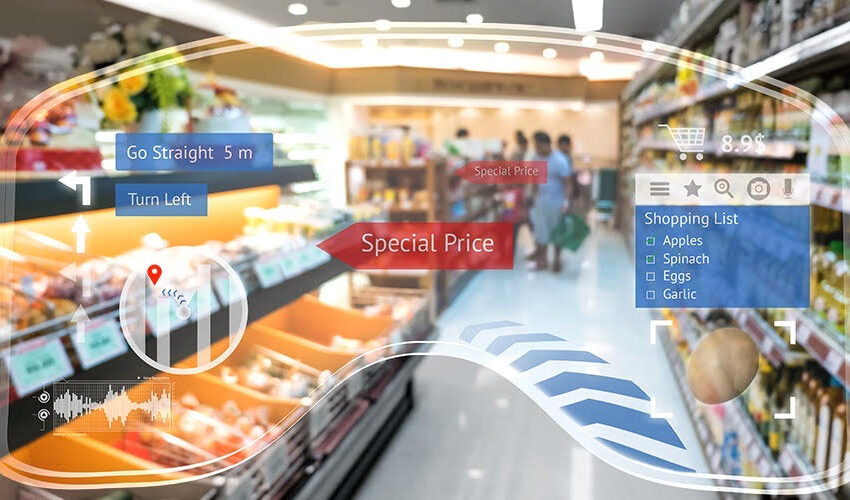Augmented reality (AR) has continuously proven to enhance our daily tasks, work, and play. Not to be confused with virtual reality (VR), AR uses our existing environment and overlays new information, allowing us to experience an interactive data-rich world. One of the most common AR experiences that has seamlessly integrated into our lives is the GPS app on our smartphones. The icons that represent different restaurants and gas stations near us and the arrows that guide us in real-time to our destination, for example, appear on our screen using AR. Another notable example of a mainstream AR experience is Pokémon GO, a mobile app game that was popularized in 2016 with 500 million users the summer it launched.
What does a digitized map on our phones and a mobile game about capturing fictitious creatures have to do with marketing strategies? A lot actually. Forecasted to increase by over 195 billion USD by 2025, AR marketing is successful in the worldwide market. Here’s why–consumers are really interested in AR. 92% of Gen Z’ers want to use AR for their shopping experiences. Brands that successfully market their product using the very tool that consumers want to experience have boosted their sales, reached larger audiences, and have even gone viral. Consumers want to be able to interact with products and make informed decisions before purchasing, AR technology allows for this to happen quickly and effortlessly.
Marketing strategies to consider
For those who want to incorporate AR into their marketing strategies, there are two important questions to ask your team: how do you want to deploy the AR experience? Do you want to use AR markers or go markerless? Let’s take a look at these options.
Deployment
- Mobile App
An AR marketing strategy can be deployed via a mobile app; users simply download the app and begin their AR experience. Using a mobile app is a great way to brand your company, and have brand presence right on a user’s phone. - WebAR
WebAR doesn’t require a user to download an app; instead, users click on a link or scan a QR code and are sent to a webpage that automatically launches the AR experience. This strategy can get users directly to your website in just one click.
Markers
- Marker-based AR
An AR marker is any visual image or object that is recognizable by smartphone cameras and that triggers an AR experience on users’ smartphones. The most common AR marker being the QR code, where users simply hold up their phone’s camera to scan and are then taken to wherever the QR code is linked to. AR markers can be QR codes, brand logos, or even text. One popular example of marker-based AR is how London’s The National Gallery art museum placed large QR codes across the city and users were able to scan them to be shown a piece of museum art on their phones, without ever having to go to the museum. This was an intelligent marketing strategy, reminding users who got to experience the AR technology from the palm of their hands that The National Gallery would be a fun place to visit. - Markerless AR
Markerless AR does not depend on a visual display, it can be used at any point by launching a mobile app or webAR experience and it will scan the environment around you, placing the AR elements onto any flat surface in front of you (like a wall or the ground.) This technology is typically used in gaming (like Pokémon GO) and online shopping (like Ikea’s AR app.) A specific subtype of markerless AR includes location-based AR, where a device’s location (taken from a device’s GPS) triggers the AR experience for the user. We see this a lot in tourism and advertising, like in Wikitude’s World Browser.
5 Companies who have successfully launched marketing campaigns using AR
As AR marketing becomes more common, knowing how you want to deploy an AR marketing experience is crucial for brand success. Let’s look at five companies that have already successfully launched marketing campaigns using AR technology.
- Pizza Hut
Using a marker-based AR strategy, this pizza chain launched their “newstalgia” (“new” + “nostalgia”) campaign using AR marketing. By scanning the marker on the limited edition pizza boxes, customers could play a nostalgic video game, Pac-Man, right from their smartphones or tablets. Pizza Hut led this clever marketing campaign to solidify themselves as a multi-generational brand, positioning themselves as generationally-relevant as Pac-Man. This campaign was accomplished using AR technology right at customers’ fingertips. - Doritos
Last summer, Doritos leveraged looser COVID-19 restrictions by launching a marketing campaign that allowed customers to enter to win concert tickets. Their AR marketing strategy consisted of using an AR marker that connected users to a WebAR experience. Users were able to see the Doritos logo and clips of live musical performances right in front of them using their smartphones. Using this technology goes beyond being a fun digital experience, it strategically aligned the brand with the positive feelings associated with summer, concerts, and an end to a fully restrictive COVID-19 era. - Vaseline
To celebrate 150 years of business, Vaseline used a marker-based AR strategy to encourage customers to download their app in order to experience the company’s operational timeline. Customers who scanned the tins of various limited edition Vaseline products were able to enjoy an AR game that taught them 150 ways to use Vaseline. This thoughtful AR marketing strategy reinforces Vaseline’s brand as a product that can be used for various needs (e.g. relieving post-shaving itchiness, restoring chapped lips, and even fixing a stuck zipper) reminding customers that buying Vaseline products is worthwhile. - Burberry
Retailers know to use AR marketing to their advantage, that is why luxury brand, Burberry, launched a campaign using marker-based WebAR. This AR marketing campaign referenced Burberry’s signature Olympia bag by allowing customers to see a Grecian statue walk around the store. This intentional idea to get customers back into their stores in the wake of COVID-19 played off the luxury purse’s namesake and encouraged customers to manipulate the AR feature as they moved about the store. Customers were able to make the statue walk towards them or create a trail of motion sequenced statues in front of them. - BON V!V
Popular spiked seltzer, BON V!V, also used a marker-based WebAR strategy to market the variety of their seltzer options. By scanning a QR code, customers were able to see an AR vending machine right in front of them and choose which seltzer they’d like to purchase online via their website. Additionally, the AR used location-based technology to direct customers to the nearest store that sells BON V!V seltzers. This AR marketing tactic had a variety of ecommerce integrations, encouraging customers to either buy a drink right then and there from their site, place an Instacart delivery order for a seltzer, or locate where the nearest store is that carries BON V!V.
Future of AR marketing
AR marketing is already proving to be successful for companies of various industries. What’s exciting about AR in general is the potential for even bigger and better AR experiences to be developed in the near future. Let’s look at two exciting AR marketing experiences that will take our future by storm.
- Apple’s AR headset
Apple has famously teased their involvement with AR technology, and we now know that most likely in 2023, we will be able to use Apple AR headsets. The release of these headsets will be very pivotal for the future of mixed reality devices. The marketing potential that brands can leverage with Apple’s AR headset is endless. A restaurant or clothing store having an AR presence through Apple’s AR headset can be incredibly beneficial to the company. For example, imagine users wearing the headset and being able to see an AR overlay pointing out a new coffee shop while walking down the street. We are excited to see where Apple takes their AR capabilities. - Snap Inc.’s Custom Landmarkers
Snap Inc. has always been a prominent player in the AR development league. Recently, they have launched an even more intentional way to make AR an everyday experience for Snapchat users, with their Custom Landmarkers creator. This feature allows users to turn local landmarks in their area into AR experiences by overlaying the physical world with digital objects. What makes this feature even better is the communal aspect– each Custom Landmarker creation will be saved in place, publicly, so that other Snapchat users can see the creation, too. Through a marketing perspective, this is a phenomenal way for businesses to advertise their products or even storefronts, by creating a brand-specific landmark for Snapchat users to see. Seeing a mixed reality feature be socially centered is exactly the future we are expecting with mixed reality experiences, like Meta’s metaverse, for example.
The future of AR experiences and AR marketing is vast and fast-paced. Companies must keep up with these technological trends in order to remain relevant and captivating to customers. At Iterate.ai, we are experts in providing in-depth analyses and recommendations that solve your innovation challenges. We know how to connect large organizations to the right startups to meet technological goals, like incorporating AR marketing into your business strategies, for example. For more information on how we can best support your vision, please connect with us here.

